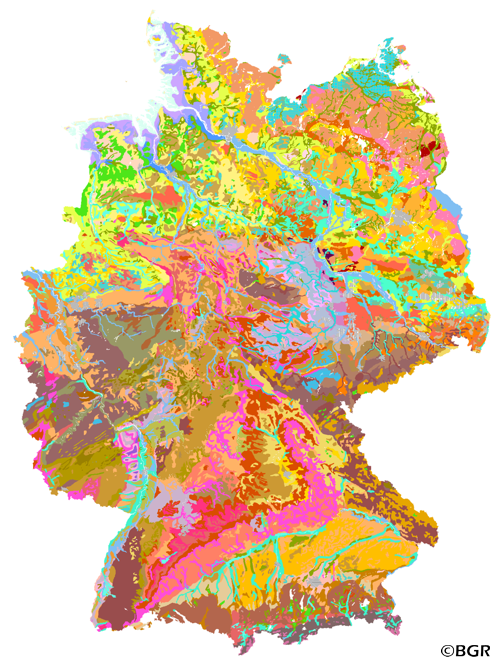Der Web Map Service (WMS) der BÜK1000 stellt bundesweit die Verbreitung der Böden und deren Vergesellschaftung in einheitlicher Form auf dem Aggregierungsniveau der Leitbodenassoziationen dar. Die Kartengrafik liegt in digitaler Form vor. In der Textlegende, die 71 bodenkundliche Legendeneinheiten umfasst, sind Angaben zu Gründigkeit, Bodenarten, Wasserverhältnissen, Ausgangsgestein sowie Leit- und Begleitböden enthalten. Die Parameter der Legendenbeschreibung und der 71 Referenzprofile (mit je 6 auf Bodenformen und 19 auf Horizonte bezogenen Angaben) sind in einer relationalen Datenbank abgelegt. Die Version 2.1 basiert auf den topographischen Grundlagen der Digitalen Topographischen Karte 1:1.000.000 (DTK1000-V) des Bundesamtes für Kartographie und Geodäsie, welche von der BGR in Teilen modifiziert wurde. Zur Verbesserung der Lagegenauigkeit wurde die Geometrie der BÜK1000 am 23.12.2013 leicht überarbeitet. Web Map Service (WMS) of the BUEK1000. The first country wide soil map at a scale of 1:1,000,000 (BUEK1000) has been compiled on the basis of published soil maps of the former German Democratic Republic and the pre 1990 federal states of Germany. To do this, it was necessary to match the soil systems used in East and West Germany and to develop standardized descriptions of soil units. A relatively homogeneous map has resulted, which permits uniform assessment of the soils throughout Germany. The map shows 71 soil mapping units, described in the legend on the basis of the German and FAO soil systems. Each soil unit has been assigned a characteristic soil profile (Leitprofil) as an aid to map interpretation. For the first time the subdivision of the country into 12 soil regions has been represented on the map. This subdivision was coordinated with the state Geological Surveys. These soil regions will represent the highest hierarchic level of nation wide soil maps in future. The colours of soil units correspond to the standards of the 'Bodenkundliche Kartieranleitung' (KA 3; Guidelines for Soil Mapping). The various hues characterize differences in relief or soil humidity. The BUEK1000 was produced digitally. It is an important part of the spatial database integrated in the Soil Information System currently being established at the Federal Institute for Geosciences and Natural Resources (FISBo BGR). It can be used together with the characteristic soil profiles to derive thematic maps related to nation wide soil protection. The scale of the BUEK1000 makes it especially suitable for small scale evaluations at federal or EU level.
Raumbezug
Lage der Geodaten (in WGS84)
| SW Länge/Breite | NO Länge/Breite | |
|---|---|---|
| 5.422°/47.02° | 15.566°/55.069° |
| Koordinatensystem |
|---|
Verweise und Downloads
Querverweise (1)
Geodatensatz
Bodenübersichtskarte der Bundesrepublik Deutschland 1:1.000.000
Die BÜK1000 stellt bundesweit die Verbreitung der Böden und deren Vergesellschaftung in einheitlicher Form auf dem Aggregierungsniveau der Leitbodenassoziationen dar. Die Kartengrafik liegt in digitaler Form vor. In der Textlegende, die 71 bodenkundliche Legendeneinheiten umfasst, sind Angaben zu Gründigkeit, Bodenarten, Wasserverhältnissen, Ausgangsgestein sowie Leit- und Begleitböden enthalten. Die Parameter der Legendenbeschreibung und der 71 Referenzprofile (mit je 6 auf Bodenformen und 19 auf Horizonte bezogenen Angaben) sind in einer relationalen Datenbank abgelegt. Die Version 2.1 basiert auf den topographischen Grundlagen der Digitalen Topographischen Karte 1:1.000.000 (DTK1000-V) des Bundesamtes für Kartographie und Geodäsie, welche von der BGR in Teilen modifiziert wurde. Zur Verbesserung der Lagegenauigkeit wurde die Geometrie der BÜK1000 am 23.12.2013 leicht überarbeitet.
Nutzung
| Nutzungsbedingungen |
Allgemeine Geschäftsbedingungen, siehe https://www.bgr.bund.de/AGB - General terms and conditions, see https://www.bgr.bund.de/AGB_en. Die bereitgestellten Informationen sind bei Weiterverwendung wie folgt zu zitieren: Datenquelle: BÜK1000 V2.1, (C) BGR, Hannover, 2013. Dieser Datensatz kann gemäß der "Nutzungsbestimmungen für die Bereitstellung von Geodaten des Bundes" (https://sg.geodatenzentrum.de/web_public/gdz/lizenz/geonutzv.pdf) genutzt werden. |
|---|
| Zugriffsbeschränkungen |
Es gelten keine Zugriffsbeschränkungen |
|---|
Kontakt
Fachinformationen
Informationen zum Datensatz
| Art des Dienstes |
Darstellungsdienste |
|---|
| Version |
OGC:WMS 1.3.0 |
|---|
| Fachliche Grundlage |
BGR (BÜK1000, 1.0), Forstplanungsämter und Staatliche Geologische Dienste der Länder von 12/1994 bis 06/1998. |
|---|
Operation
| Name der Operation | Beschreibung der Operation | Aufruf der Operation | |
|---|---|---|---|
| GetCapabilities |
https://services.bgr.de/wms/boden/buek1000de/? |
||
| GetCapabilities Dokument | Kartenansicht öffnen |
|---|
Zusatzinformationen
Konformität
| Spezifikation der Konformität | Spezifikationsdatum | Grad der Konformität | Geprüft mit |
|---|---|---|---|
| VERORDNUNG (EG) Nr. 976/2009 DER KOMMISSION vom 19. Oktober 2009 zur Durchführung der Richtlinie 2007/2/EG des Europäischen Parlaments und des Rates hinsichtlich der Netzdienste | 20.10.2009 | siehe dazu die angegebene Durchführungsbestimmung |
Datenformat
| Name | Version | Kompressionstechnik | Spezifikation |
|---|---|---|---|
| png | n/a | ||
| jpeg | n/a | ||
| gif | n/a |





